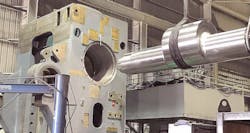The recent recession, disruptions in the global supply chain, and consolidation among forging operations have combined to create potential opportunities for domestic forgers to pick up new business in 2021. However, these operations must be poised to satisfy demand, as well as take advantage of additional business that may be “reshored” as North American manufacturers look to shorten lead times and their supply chain by engaging domestic suppliers.
So, forgers looking to rebound in the new year would be wise to consider the axiom, “Luck is what happens when preparation meets opportunity.”
Keeping all this in mind, many forgers are wisely taking time to prepare for opportunity. That is, they are re-evaluating their production processes and seeking new ways to improve production efficiency, as part of their post-crisis rebound and recovery strategy.
To the extent funding is available that may include finding fast, economical ways to repair or acquire equipment that will make possible higher-volume production. For the far sighted, it may also mean rebuilding or remanufacturing machinery to take advantage of high-production, labor-saving automation.
Rapid repair -- Scheduling necessary repairs is the obvious first step to get ready for an economic rebound. “The most immediate and economical option is to repair existing or out-of-commission units to get them up and running to spec with greater efficiency. This can be as simple as replacing parts that are worn, out-of-tolerance, or broken to bring the machinery back online,” said Ken Copeland, president of Ajax-CECO, a manufacturer of forging equipment since 1875.
In recent years, notably with its acquisition of Erie Press Systems, Ajax-CECO has expanded into a one-stop, expedited domestic source for forging equipment. It is the largest OEM forging equipment supplier in North America.
According to Copeland, the most needed repairs to forging equipment usually involve perishable items that are common to every machine, including friction plates and driving plates for presses and upsetters, or piston heads, rods, rings, and packings for hammers.
He said that the parts for these most needed repairs should be in stock at reputable domestic suppliers.
“However, forging operations still may get into trouble when a part they need to replace was built decades ago and the forger doesn’t know if the OEM is in business or if a drawing of the part exists,” he added.
According to Copeland, problems occur when forgers send parts to machine shops to be reverse-engineered and machined. Machine shops often have no access to critical specifications about high-wear parts, including the material grade of the steel, the heat-treating process applied, and or the tolerances that were established specifically for that piece.
“The result can be parts that prematurely wear or fail,” he cautioned.
Instead, it is often a better choice to rely on OEMs like Ajax-CECO, which offer stocking programs for long lead time items such as main gears, eccentric shafts, rams, etc. that are usually not stocked by forgers due to the cost. In this type of program, the part is held in inventory for the forger. The forger pays a percentage of the cost and then the balance when they take possession of the part – even if years later.
According to Copeland, a custom stocking program with minimal up-front investment can eliminate months of downtime due to long-lead-time parts. Instead, multiple machines with parts of similar size and design can have the parts manufactured to a semi-finished state in preparation for use with any of the machines. When needed, the exact dimensions for the down machine can be provided so the part can be completed to spec, ready to install.
In a down economy, however, most forgers are less comfortable placing a purchase order for a new machine that may take one year to deliver. They want more economical options that can be brought online quickly.
In this way, a rebuild or remanufacture of existing forging equipment are still feasible options. A plus to this approach is that high-productivity, labor-saving automation can be added.
Expedited rebuild and remanufacture -- When the scope of work goes beyond repair, a machine rebuild is an economical, accelerated option to bring additional equipment online.
“Depending on the scope of the work, equipment rebuilds are ideal because the process can take as little as a few months to be operational. In a rebuild, all high wear items such as bearings, bushings, seals and liners should be replaced to get the machine in good working condition,” said Copeland.
According to Copeland, rebuilds can be performed on-site, or the unit can be shipped to the OEM’s manufacturing location, which reduces the rebuild costs. Once there, the machine is completely disassembled, cleaned, and inspected. Upon completion of the inspection, a report of findings is submitted to the customer, including a list of missing components as compared to the “as-built” bill of material; findings of concern that may impact operation; and a description and pictures of the general condition of the parts. This is provided together with a general scope of work and the estimated cost for the rebuild and re-commissioning of the machine.
If even more extensive work is required, remanufacturing still save time over buying new machinery.
“Remanufacturing basically means stripping the machine down its cast frame and replacing all the internal parts,” Copeland said. “With a remanufacture, you save time having a new frame cast. Remanufacture can be completed faster than buying new at about 85% to 90% of the cost, and usually would carry a ‘new machine’ warranty.”
One of the advantages of rebuilding or remanufacturing forging equipment is that the scope of work also can include adding significant automation upgrades.
Many of the tasks that are performed manually – such as moving heavy steel rods, pipe and other stock in and out of equipment – can be automated. This could be with the mechanical “hand” of a robot or by integrating servos that can lift, insert, and deposit materials. Even tasks such as automated tooling changes can be completed with the push of a button.
Automation creates a safer environment for forging operators and increases productivity. "By automating forging operations to perform some of the tasks of a human operator, productivity can increase from several hundred pieces per hour up to 3,000, depending on the type of products being forged. At the same time, it gives the plant the ability to maintain recommended social distancing," according to Copeland.
Preparing for opportunity -- While forgers prepare for an expected economic rebound in 2021, now is actually a good time to work with forging equipment OEMs. Once challenge they always face is shutting down a production line for repairs for any length of time. However, OEMs can work with forgers to develop a plan to minimize downtime by reviewing the machine’s bill of materials, reviewing past repair orders, and manufacturing critical parts that will need to be replaced.
In addition, the OEM will have the original design specifications, critical materials, and clearance specifications to move forward with repairs or rebuilds and quickly get the work done. Information like critical data on high-wear parts, the material grade of the steel, the heat-treating process applied, and the required clearances that were used in the engineering of that particular forging machine all are needed for a quality repair, rebuild, or remanufacture.
Del Williams is a technical writer in Torrance, Calif.
About the Author

Del Williams
Del Williams is a technical writer based in Torrance, California. He writes about health, business, technology, and educational issues and has an M.A. in English from C.S.U. Dominguez Hills.
